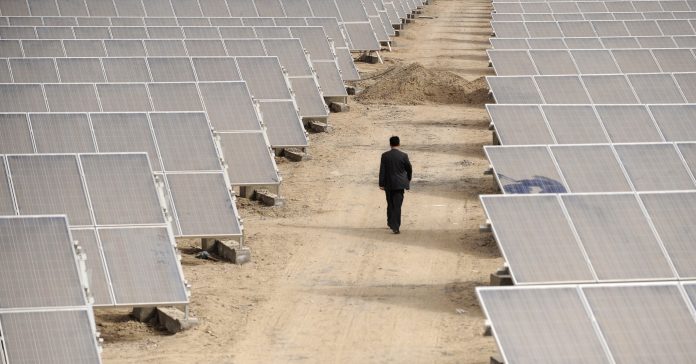
A man walks through solar panels at a solar power plant under construction in Aksu, Xinjiang Uighur Autonomous Region, April 5, 2012.
This project was supported by the Eyebeam Center for the Future of Journalism, the Pulitzer Center, and the Open Technology Fund.
Solar power has built a reputation as a virtuous industry, saving the planet by providing clean energy. But the industry has a dirty underbelly: It relies heavily on Xinjiang — a region in China that has become synonymous with forced labor for Muslim minorities — for key components.
Over the past four years, China has detained more than a million people in a network of detention facilities throughout its Xinjiang region. Many of these camps contain factories where Muslim minorities are forced to work. The solar industry is overwhelmingly reliant on parts and materials imported from this region, where heavy government surveillance makes it nearly impossible for outside observers to assess if people are working of their own free will. However, there are few alternative suppliers for the components the solar industry in the US needs.
It’s a particular problem for polysilicon, the metallic gray crystal form of the element integral to making solar cells, which convert light into energy. In 2016, only 9% of the world’s solar-grade polysilicon came from Xinjiang. But by 2020 it provided about 45% of the world’s supply, according to industry analyst Johannes Bernreuter.
At least one major Chinese polysilicon manufacturer has close ties with a state-controlled paramilitary organization, the Xinjiang Production and Construction Corps (XPCC). Last year, the US government slapped sanctions on the XPCC for helping Beijing carry out its mass internment of Muslims, and the US banned its cotton, citing evidence it was produced using forced labor.
The American solar industry faces a choice: ignore the risk of human rights abuses or develop costly new alternatives for an industry struggling to compete against more polluting forms of energy production.
Another major Chinese polysilicon producer said it works with “vocational schools” in Xinjiang, a red flag because the Chinese government has long used that term as a euphemism for internment camps.
The Solar Energies Industry Association, which represents solar companies in the United States, opposes the “reprehensible” human rights violations in Xinjiang and is “encouraging” companies to move their supply chains out of the region, said John Smirnow, the group’s general counsel.
“We have no indication that solar is being directly implicated, he said, “but given reports, we want to ensure forced labor is never a part of the solar supply chain.”
But as President-elect Joe Biden prepares to take office, after promising to improve clean energy infrastructure in the US, the American solar industry faces a choice: ignore the risk of human rights abuses or develop costly new alternatives for an industry struggling to compete against more polluting forms of energy production.
A worker produces polysilicon quartz rods in Donghai County, Jiangsu Province, China, on June 30, 2020.
China came to dominate the global polysilicon industry after it put tariffs on polysilicon imports from the US, South Korea, and the EU and ramped up domestic production, in apparent retaliation against US-imposed tariffs, in 2014. China is also one of the world’s biggest consumers of polysilicon, which meant it became less desirable for many companies outside China to compete because it was no longer cost-effective to export it there. In the years since, China’s polysilicon industry has thrived, not just in Xinjiang but in other regions such as the southwestern province of Sichuan.
“Most of the supply chain is concentrated in China, and most of the rest in southeast Asia is in plants owned by Chinese companies,” said Bernreuter. “There is no large alternative for the supply chain.”
But imports from Xinjiang have drawn the ire of lawmakers in the United States in recent months.
In the last Congress, representatives considered a bill that would have banned all goods from the region, a piece of legislation likely to be revived in the upcoming session. The House bill specifically targeted “poverty alleviation” programs that move Xinjiang’s Muslims to work in factories and on farms away from their hometowns.
“It’s almost impossible to confidently assess the labor conditions in Xinjiang.”
Since late 2016, the Chinese government has imposed a campaign that has included mass detention, digital surveillance, indoctrination, and forced labor on a population of about 13 million Muslim minorities in the far west region of Xinjiang, including ethnic Uighurs, Kazakhs, and others. Non-Chinese people visiting Xinjiang are often heavily monitored or escorted by police officers, so it is very difficult for companies to audit their supply chains for forced labor, experts say.
“It’s almost impossible to confidently assess the labor conditions in Xinjiang just because it’s almost impossible to get a competent assessor into the region. And then their ability to interview workers, especially Uighur workers, is limited because of the surveillance,” Amy Lehr, director of the human rights program at the Center for Strategic and International Studies in Washington, DC, and the lead author of a report on forced labor in the region, told BuzzFeed News.
But US Customs and Border Protection already has the legal authority to ban imports from the region if it suspects forced labor has been used. The agency stopped a shipment of human hair from Xinjiang in July based on reports that the extensions were made using prison labor. In December, CBP seized shipments of cotton and computer parts from Xinjiang. This week, it banned imports of tomato and cotton products from the region over what it called “slave labor.”
“It’s quite possible solar companies could be scrutinized by CBP regarding Xinjiang-related forced labor risks in their supply chains even if there is no regional ban because this issue is getting more attention,” said Lehr.
The research group Horizon Advisory said in a report that polysilicon from Xinjiang frequently lands in the US.
“Those goods enter the United States from China both directly and via indirect trans-shipment and processing in several other countries, including Thailand, Malaysia, Korea, Singapore, and Vietnam,” the report says, concluding that “exposure to forced labor is pervasive” in the industry, including in “solar panels imported and installed in the United States.”
Forced labor is typically used for manufacturing jobs that don’t require specialized skills. Some of these types of tasks, like breaking apart tubes of the material, are used in the production of polysilicon.
If the US did ban polysilicon imports from China, industry experts say US-based companies would have enough capacity to make up for the shortfall, but would face higher costs and other problems in the supply chain.
For one thing, other parts used in solar panels are dominated by Chinese manufacturing as well. Once polysilicon is made, it’s sliced up into tiny nuggets called “wafers.” The overwhelming majority of wafer makers are located in China. And compared to other parts of China, it’s cheaper to manufacture polysilicon in Xinjiang, where companies can receive large subsidies from the government and the cost of electricity, provided by coal plants, and wages are typically lower than in wealthier parts of China.
REC Silicon, a Norwegian polysilicon maker whose manufacturing facilities are based in the US, invested more than a billion dollars in building a polysilicon factory in Washington state. After the Chinese tariffs on US goods hit, the company had to first slow production and then completely shut it down in 2019.
And the industry could face more domestic difficulties ahead. An executive with Hemlock Semiconductor Group, a US-based polysilicon maker, told investors on Oct. 22 that he was “fairly convinced” a US government investigation into the solar supply chain is coming.
Satellite photos showing the construction sequence of Daqo’s polysilicon plant
Most of Xinjiang’s polysilicon is made by four Chinese companies, which are among the six biggest suppliers of the material in the world. One, the Daqo New Energy Corp, is listed on the New York Stock Exchange. With that comes transparency requirements that allow a better understanding of how it operates.
According to Chinese state media reports and the company’s website, it has close ties with a Chinese state-controlled paramilitary organization called the Xinjiang Production and Construction Corps (XPCC) — an organization so powerful that it administers cities in the region. Known best in Chinese simply as “the corps,” its activities have included helping Han Chinese migrants settle in Xinjiang and administering farms. The XPCC issued a policy document in 2013 setting solar energy as one of its “development goals.”
In July, the US government put the XPCC under sanctions, saying it had helped implement Beijing’s mass internment policy targeting Muslims. On Dec. 2, the US banned cotton imports produced by the XPCC, citing evidence it uses forced labor.
The XPCC could not be reached for comment.
In public filings made in October with the US Securities and Exchange Commission, Daqo disclosed that it gained “additional advantages” in electricity costs because the XPCC operates the regional power grid. The local state newspaper reported that XPCC paid Daqo subsidies amounting to more than 489,447 yuan (approximately $75,000). The companies received millions more in subsidies from the government of Shihezi, a city in Xinjiang administered by the XPCC. In a Chinese language press release, Daqo’s Xinjiang subsidiary has also noted that it’s considered an “innovative enterprise pilot unit” of the XPCC.
Daqo’s polysilicon plant is located just over 7 miles north of Shihezi City. Construction started in spring 2011, when an area of farmland the size of 110 football fields was cleared to make way for the plant. By 2013, it was complete, with large industrial buildings covering the site, linked together by a network of elevated pipes. In 2014, the compound was extended by a further 3 million square feet, and over the following two years, new buildings continued to be added. The latest growth of the plant took place over the summer of 2019. Another 3 million square feet were added at the southwest end of the compound, and parts of the site that had previously sat unused were filled in with buildings. The plant now covers 12.2 million square feet, the equivalent of 215 football fields.
Daqo could not be reached for comment, but has previously said it does not use forced labor “under any circumstances whether in its own facilities or throughout its entire supply chain.”
In Xinjiang, programs euphemistically described as “poverty alleviation” have been linked to forced labor, according to research by CSIS and other organizations.
“It would be unsustainable to have an industry built on coal and slave labor.”
One of the other big polysilicon makers in Xinjiang, GCL-Poly Energy, said it works with “vocational schools” in Xinjiang in an annual report. The government has long referred to the internment camps in the region as vocational schools. Chinese language news articles also say GCL-Poly takes part in poverty alleviation programs.
GCL-Poly could not be reached for comment.
The industry has to make a choice, said Francine Sullivan, vice president for business development at REC Silicon, the Norwegian polysilicon maker.
“It would be unsustainable to have an industry built on coal and slave labor,” she said. “Most people in solar think it’ll be greenwashed away from us. We don’t have to deal with it because we’re solar.” ●





